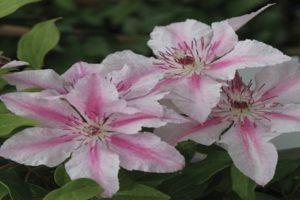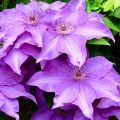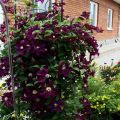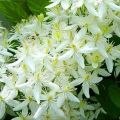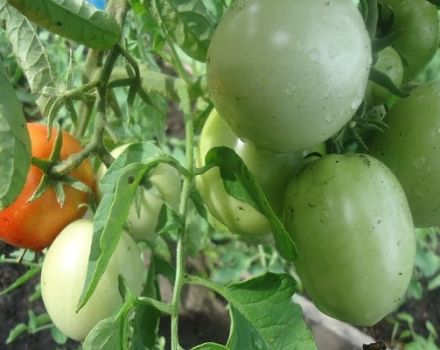Description and cultivation of clematis hybrid variety Mrs. Cholmondeli
Clematis of the Mrs. Cholmondeli variety is a perennial vine, a representative of the Buttercup family. The main advantage of an ornamental plant is its ability to bloom continuously and profusely throughout the calendar summer, twisting around the support. Its wide purple petals look impressive against the background of bright green leaves. The plant will decorate any personal plot, will become the real pride of the gardener.
Description and characteristics of clematis Mrs. Cholondeli
The scientific (Latin) name for the climbing plant is Clematis Mrs Cholmondeley. Its appearance is as follows:
- In a young vine, the stem is relatively weak and thin. And in an adult it is woody.
- It can grow up to 3.5 meters in height.
- The variety is large-flowered, semi-double flowers with a diameter of 20-23 centimeters, light blue in color, with a delicate purple tint. Inside are small, yellow and light brown stamens.
- The root system is powerful, deeply embedded in the ground.
Light green leaf blades are small (5 centimeters long, 2 centimeters wide), oblong, with a pointed end. The hybrid plant looks picturesque.
Advantages and disadvantages of the variety
Experienced gardeners note the following advantages of the Holmondeley variety:
- Unpretentious care. They do not require complex manipulations during planting and growing.
- Suitable for vertical gardening. They are planted in prominent places, near various garden supports (fences, trellises, arbors).
- Perennial perfectly tolerate Russian winters.
Clematis Mrs. Cholmondeli also has negative characteristics:
- The background for the vines should be dark or yellow-flowering and yellow-leaved bushes should be nearby. Flowers surrounded by other colors do not look as impressive.
- An ornamental plant has no immunity to fungal diseases, powdery mildew, and rot.
- Pest insects can attack leaves and stems.
But, despite the disadvantages, many gardeners prefer to grow an ornamental plant near the house..
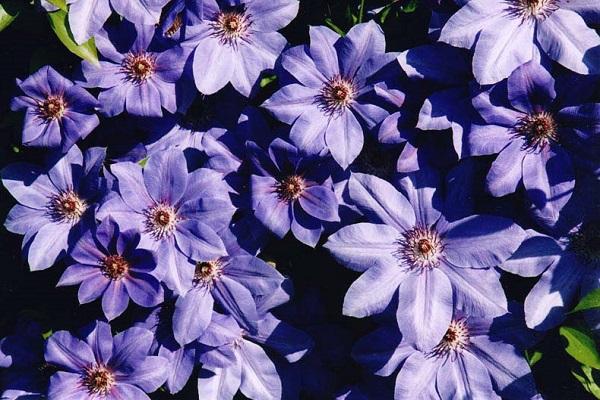
Landing nuances
Mrs. Cholmondeli's clematis seedlings are usually sold in several forms:
- in a special package, where the root system of an annual plant is in a moist substrate;
- thin stem with root;
- roots with buds or sprouts.
Representatives of the Buttercup family are photophilous, so they are planted in a sunny place, protected from drafts. Suitable neutral or slightly alkaline, fertile, loose soil.A climbing plant will not grow on salty, damp, heavy, acidic soils.
If the entire area is clayey, a drainage system is made at the site of Mrs. Cholmondeli's clematis planting. And the plant itself is planted in a hole filled with a light, fertilized mixture. Do not add sour peat or fresh manure before planting.
Groundwater should not come close to the soil surface.

Supports for vines should be at a distance of 30-32 centimeters from walls and fences. Do not allow rainwater from the roof to fall on ornamental plants.
When to plant?
Clematis Mrs. Cholmondeli is planted in the spring - when the ground thaws, or in the fall - before the onset of frost.
Preparation of planting material
Before planting in a permanent place, the seedling is taken out of the package. For clematis Mrs. Cholmondeli to take root better, the roots are soaked in warm, settled water for a couple of hours.

Planting process
Dig a hole in the prepared place. A layer of fertilized mixture is poured into it, a perennial is placed on it, so that the root shoots are straightened. Then the hole is covered with soil, making sure that the root does not peep out of the ground. The soil around the young plant is tamped, watered and sprinkled with hay or rotted sawdust.
Care Tips
The care is simple - it includes the procedures that gardeners perform with any crop.
Watering
The ornamental plant is watered regularly, but in moderation, keeping an eye on the degree of drying of the soil. If the vine is irrigated too abundantly, then this is fraught with stagnation of water at the root system. And this will lead to the occurrence of diseases.

Top dressing
Top dressing begins from the second year of life. Fertilizers with nitrogen content are applied in spring. When buds appear, a representative of the Buttercup family requires complex fertilizer. At the beginning of autumn, fertilize with potash, phosphorus preparations.
Trimming
An ornamental plant requires periodic pruning. It is carried out in the autumn. All side shoots are removed, leaving the main stem. Moreover, it is pinched at a distance of 0.5 meters from the ground. After a year, the damaged parts are removed. Then the top is cut off from one peduncle. And for the rest, they leave a length of 10 centimeters.
These manipulations will rejuvenate the perennial, stimulate abundant flowering and rapid growth of lateral stems next spring.
Preparing for the winter period
The perennial is covered before the first autumn frosts. The main peduncle is covered with peat to a height of 7-10 centimeters. This measure will protect the stem. The land around the representative of the Buttercup family is laid with hay, and on top - with a spruce forest. The plant itself is lowered, twisted and covered with spunbond. A small layer of soil and roofing material are piled on top. The whole structure is dug up with heavy boards so that the strong wind does not destroy it.

Disease and pest control
For the prevention of various diseases, a climbing plant is treated with a solution of cuprum-containing fungicides before and after flowering. And in the summer, they are sprayed with insecticides a couple of times to prevent the attack of pests.
Reproduction
You can propagate a perennial in the spring or autumn by dividing. They choose a strong, well-developed liana over 5 years old, dig it out without damaging the root system. Divide the plant into several parts with 2-3 living buds. Then they are seated in different holes.
Clematis Mrs. Cholmondeli is a beautiful climbing plant that can grow and bloom in harsh climates. If you follow all the rules for cultivating a culture, then there will be no problems with growing vines. The most beautiful flowers that adorn a perennial for more than one month are a great reason to grow it in the garden..
